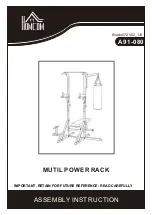
8
In case a load falls, the type and size of the fasteners must be able to withstand dynamic stresses as indicated on the table in the Anchorage Resistance
column.
To allow for different uses and orientations, the upper section of the 1000 kg load arrester is detachable (see Diagram 2). To use this configuration,
remove the screws and lock nuts (3), as well as the two black metal brackets (4), then use the holes (5) on both sides of the steel casing to attach this
section in the chosen orientation. Welding the device’s casings to the structure or load is prohibited.
It is recommended to perform these verifications before each use. Beyond 60 cycles per day, you must systematically check the fall arrester before the
start of each work shift. The verification must be made based on the following criteria:
1. Check the retractable system of the wire rope by unwinding it completely and check that the return of the wire rope is done in its totality. BE CARE
-
FUL, always accompany the wire rope by slowing it.
2. No wear, deformations, corrosion, or oxidation over the entire length of the wire rope.
3. Check at the beginning, at the middle and at the end of the wire rope the blocking of the wire rope unwinding by pulling firmly on the wire rope end.
4. No wear or deformation of the anchor points on the device, on the load, as well as on the structure.
5. No wear or deformation of the connection parts.
6. Checking the overall condition of the wire rope housings and outlet
7. Checking for the presence and legibility of the markings
It is important to have a load recovery plan for after arresting a fall. Once the load arrester has arrested a falling load, the load is suspended by the wire
rope, and if load-securing manoeuvres require it to be lowered, it is then important to lift it slightly before releasing the locking system and manoeuvre
it in order to place the load on the ground. It is important to perform these manoeuvres after taking the necessary precautions so that the load no longer
presents a danger for operators or property.
The device must be returned for a full check by the manufacturer or a competent person authorized by the manufacturer. The anchor point, the connec
-
tion parts, as well as the structure must also be checked by a competent person.
Our load arrester requires regular maintenance; the frequency of this maintenance may vary based on use, frequency, and the environment the device
is used in. In order to ensure its resistance and therefore the safety of personnel and property, this maintenance must be performed after arresting a fall,
in the event of wear or a malfunction, and at least every twelve months, by the manufacturer or a competent person authorized by the manufacturer.
WARNING: These load arresters are not lifting devices, but security equipment used as a complement to a lifting device. In no case they should be
checked in compliance with the practices of lifting devices. The loading of this equipment is strictly forbidden because it puts a strain on the braking
and energy absorption system integrated to the internal mechanism and is likely, when stopping a subsequent fall, to reduce its capacities. Only the
verifications recommended by the manufacturer are in a position to ensure the integrity of the product.
The product data sheet should be completed (in writing) after each verification. The date of inspection and date of the next inspection must be indicated
on the data sheet. It is also recommended to put the date of the next inspection on the product.
The service life of the load arrester is 10 years, if and only if the mandatory periodic checks performed by the manufacturer or a competent person
authorized by the manufacturer are performed at least every 12 months starting from the product’s service start date.
During transport, keep the product in its packaging, well away from any cutting surface and keep the device in its original packaging. Clean it with
water, wipe it with a rag and hang it up in a well-ventilated location, to let it dry naturally and away from a naked flame or heat source; follow the same
procedure for components that have become damp during use. The system must be stored in its packaging in a dry, well-aired place protected from
extremes of temperature
CHECK BEFORE USE
OPERATION AND PRECAUTIONS AFTER A FALL
VERIFICATIONS
SERVICE LIFE
STORAGE AND MAINTENANCE






































